Nefertiti
Nefertiti (/ˌnɛfərˈtiːti/[3]) (c. 1370 – c. 1330 BC) was a queen of the 18th Dynasty of Ancient Egypt, the great royal wife of Pharaoh Akhenaten. Nefertiti and her husband were known for their radical overhaul of state religious policy, in which they promoted the earliest known form of monotheism, Atenism, centered on the sun disc and its direct connection to the royal household. With her husband, she reigned at what was arguably the wealthiest period of ancient Egyptian history.[4] Some scholars believe that Nefertiti ruled briefly as Neferneferuaten after her husband's death and before the ascension of Tutankhamun, although this identification is a matter of ongoing debate.[5][6] If Nefertiti did rule as Pharaoh, her reign was marked by the fall of Amarna and relocation of the capital back to the traditional city of Thebes.[7]
| Nefertiti | |||||
|---|---|---|---|---|---|
 | |||||
| Queen consort of Egypt | |||||
| Tenure | 1353–1336 BC[1] or 1351–1334 BC[2] | ||||
| Pharaoh | |||||
| Reign | c. 1334–1332 BC | ||||
| Predecessor | Smenkhkare | ||||
| Successor | Tutankhamun | ||||
| Born | c. 1370 BC Thebes, Egypt | ||||
| Died | c. 1330 BC | ||||
| Spouse | Akhenaten | ||||
| Issue | |||||
| |||||
| Dynasty | 18th of Egypt | ||||
| Father | Ay (possibly) | ||||
| Mother | Iuy (possibly) | ||||
| Religion | Atenism | ||||
| Neferneferuaten-Nefertiti in hieroglyphs | ||||||||||||||
|---|---|---|---|---|---|---|---|---|---|---|---|---|---|---|
Neferneferuaten Nefertiti Nfr nfrw itn Nfr.t jy.tj Beautiful are the Beauties of Aten, the Beautiful one has come | ||||||||||||||
She was made famous by her bust, now in Berlin's Neues Museum. The bust is one of the most copied works of art of ancient Egypt. It was attributed to the sculptor Thutmose, and it was found in his workshop.
Names and titles
Nefertiti had many titles, including:
- Hereditary Princess (iryt-p`t)
- Great of Praises (wrt-Hzwt)
- Lady of Grace (nebet-imat, nbt-jmꜣt)
- Sweet of Love (beneret-merut, bnrt-mrwt)
- Lady of The Two Lands (nebet-tawi, nbt-tꜣwj)
- Main King's Wife, his beloved (hemet-nesut-aat meretef, ḥmt-nswt-ꜥꜣt mrt.f)
- Great King's Wife, his beloved (hemet-nesut-weret meretef, ḥmt-nswt-wrt mrt.f)
- Lady of All Women (henut-hemut-nebut, ḥnwt-ḥmwt-nbwt)
- Mistress of Upper & Lower Egypt (henut-shemau-mehu, ḥnwt-šmꜣw-mḥw).[8]
While modern Egyptological pronunciation renders her name as Nefertiti, her name was the sentence nfr.t jj.tj “the beautiful one has come” and probably contemporarily pronounced Naftita from older Nafrat-ita or perhaps Nafert-yiti.[9][10] Nefertiti's name, Egyptian Nfr.t-jy.tj, can be translated as "The Beautiful Woman has Come".[11]
Family and early life
Almost nothing is known about Nefertiti's life prior to her marriage to Akhenaten. Scenes from the tombs of the nobles in Amarna mention that Nefertiti had a sister, named Mutbenret.[12][13][14] Further, a woman named Tey carried the title of "Nurse of the Great Royal Wife."[15] In addition, Tey's husband Ay carried the title "God's Father." Some Egyptologists believe that this title was used for a man whose daughter married the pharaoh.[16] Based on these titles, it has been proposed that Ay was in fact Nefertiti's father.[11] However, neither Ay nor Tey are explicitly referred to as Nefertiti's parents in the existing sources. At the same time, no sources exist that directly contradict Ay's fatherhood which is considered likely due to the great influence he wielded during Nefertiti's life and after her death.[11] According to another theory, Nefertiti was the daughter of Ay and a woman besides Tey, but Ay's first wife died before Nefertiti's rise to the position of queen, whereupon Ay married Tey, making her Nefertiti's stepmother. Nevertheless, this entire proposal is based on speculation and conjecture.[17]
It has also been proposed that Nefertiti was Akhenaten's full sister, though this is contradicted by her titles which do not include the title of "King's Daughter" or "King's Sister," usually used to indicate a relative of a pharaoh.[11] Another theory about her parentage that gained some support identified Nefertiti with the Mitanni princess Tadukhipa,[18] partially based on Nefertiti's name ("The Beautiful Woman has Come") which has been interpreted by some scholars as signifying a foreign origin.[11] However, Tadukhipa was already married to Akhenaten's father and there is no evidence for any reason why this woman would need to alter her name in a proposed marriage to Akhenaten, nor any hard evidence of a foreign non-Egyptian background for Nefertiti.
The exact dates when Nefertiti married Akhenaten and became the king's great royal wife are uncertain. They are known to have had at least six daughters together, including Meritaten, Meketaten, Ankhesenpaaten (later called Ankhesenamun when she married Tutankhamun), Neferneferuaten Tasherit, Neferneferure, and Setepenre.[14][18] She was once considered as a candidate for the mother of Tutankhamun, however a genetic study conducted on discovered mummies suggests that she was not.[19]
Life

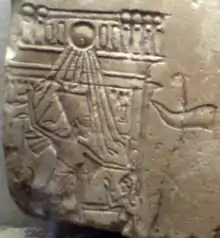
Nefertiti first appears in scenes in Thebes. In the damaged tomb (TT188) of the royal butler Parennefer, the new king Amenhotep IV is accompanied by a royal woman, and this lady is thought to be an early depiction of Nefertiti. The king and queen are shown worshiping the Aten. In the tomb of the vizier Ramose, Nefertiti is shown standing behind Amenhotep IV in the Window of Appearance during the reward ceremony for the vizier.[18]
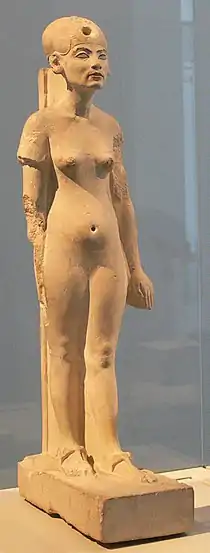
During the early years in Thebes, Akhenaten (still known as Amenhotep IV) had several temples erected at Karnak. One of the structures, the Mansion of the Benben (hwt-ben-ben), was dedicated to Nefertiti. She is depicted with her daughter Meritaten and in some scenes the princess Meketaten participates as well. In scenes found on the talatat, Nefertiti appears almost twice as often as her husband. She is shown appearing behind her husband the pharaoh in offering scenes in the role of the queen supporting her husband, but she is also depicted in scenes that would have normally been the prerogative of the king. She is shown smiting the enemy, and captive enemies decorate her throne.[20]
In the fourth year of his reign, Amenhotep IV decided to move the capital to Akhetaten (modern Amarna). In his fifth year, Amenhotep IV officially changed his name to Akhenaten, and Nefertiti was henceforth known as Neferneferuaten-Nefertiti. The name change was a sign of the ever-increasing importance of the cult of the Aten. It changed Egypt's religion from a polytheistic religion to a religion which may have been better described as a monolatry (the depiction of a single god as an object for worship) or henotheism (one god, who is not the only god).[21]
The boundary stelae of years 4 and 5 mark the boundaries of the new city and suggest that the move to the new city of Akhetaten occurred around that time. The new city contained several large open-air temples dedicated to the Aten. Nefertiti and her family would have resided in the Great Royal Palace in the centre of the city and possibly at the Northern Palace as well. Nefertiti and the rest of the royal family feature prominently in the scenes at the palaces and in the tombs of the nobles. Nefertiti's steward during this time was an official named Meryre II. He would have been in charge of running her household.[5][18]
Inscriptions in the tombs of Huya and Meryre II dated to Year 12, 2nd month of Peret, Day 8 show a large foreign tribute. The people of Kharu (the north) and Kush (the south) are shown bringing gifts of gold and precious items to Akhenaten and Nefertiti. In the tomb of Meryre II, Nefertiti's steward, the royal couple is shown seated in a kiosk with their six daughters in attendance.[5][18] This is one of the last times princess Meketaten is shown alive.
Two representations of Nefertiti that were excavated by Flinders Petrie appear to show Nefertiti in the middle to later part of Akhenaten's reign 'after the exaggerated style of the early years had relaxed somewhat'.[22] One is a small piece on limestone and is a preliminary sketch of Nefertiti wearing her distinctive tall crown with carving began around the mouth, chin, ear and tab of the crown. Another is a small inlay head (Petrie Museum Number UC103) modeled from reddish-brown quartzite that was clearly intended to fit into a larger composition.
Meketaten may have died in year 13 or 14. Nefertiti, Akhenaten, and three princesses are shown mourning her.[23] The last dated inscription naming her and Akhenaten comes from a building inscription in the limestone quarry at Dayr Abū Ḥinnis. It dates to year 16 of the king's reign and is also the last dated inscription naming the king.[24]
Possible reign as Pharaoh
Many scholars believe Nefertiti had a role elevated from that of great royal wife, and was promoted to co-regent by her husband Pharaoh Akhenaten before his death.[25] She is depicted in many archaeological sites as equal in stature to a King, smiting Egypt's enemies, riding a chariot, and worshipping the Aten in the manner of a pharaoh.[26] When Nefertiti's name disappears from historical records, it is replaced by that of a co-regent named Neferneferuaten, who became a female Pharaoh.[27] It seems likely that Nefertiti, in a similar fashion to the previous female Pharaoh Hatshepsut, assumed the kingship under the name Pharaoh Neferneferuaten after her husband's death. It is also possible that, in a similar fashion to Hatshepsut, Nefertiti disguised herself as a male and assumed the male alter-ego of Smenkhkare; in this instance she could have elevated her daughter Meritaten to the role of great royal wife.
If Nefertiti did rule Egypt as Pharaoh, it has been theorized that she would have attempted damage control and may have re-instated the ancient Egyptian religion and the Amun priests, and had Tutankhamun raised in with the traditional gods.[28]
Archaeologist and Egyptologist Dr. Zahi Hawass theorized that Nefertiti returned to Thebes from Amarna to rule as Pharaoh, based on ushabti and other feminine evidence of a female pharaoh found in Tutankhamun's tomb, as well as evidence of Nefertiti smiting Egypt's enemies which was a duty reserved to kings.[29]
Death

Old theories

Pre-2012 Egyptological theories thought that Nefertiti vanished from the historical record around Year 12 of Akhenaten's reign, with no word of her thereafter. Conjectured causes included injury, a plague that was sweeping through the city, and a natural cause. This theory was based on the discovery of several ushabti fragments inscribed for Nefertiti (now located in the Louvre and the Brooklyn Museum).
A previous theory that she fell into disgrace was discredited when deliberate erasures of monuments belonging to a queen of Akhenaten were shown to refer to Kiya instead.[14]
During Akhenaten's reign (and perhaps after), Nefertiti enjoyed unprecedented power. By the twelfth year of his reign, there is evidence she may have been elevated to the status of co-regent:[30] equal in status to the pharaoh, as may be depicted on the Coregency Stela.
It is possible that Nefertiti is the ruler named Neferneferuaten. Some theorists believe that Nefertiti was still alive and held influence on the younger royals. If this is the case, that influence and presumably Nefertiti's own life would have ended by year 3 of Tutankhaten's reign (1331 BC). In that year, Tutankhaten changed his name to Tutankhamun. This is evidence of his return to the official worship of Amun, and abandonment of Amarna to return the capital to Thebes.[5]
New theories
In 2012, the discovery of an inscription dated to Year 16, month 3 of Akhet, day 15 of the reign of Akhenaten was announced.[31] It was discovered within Quarry 320 in the largest wadi of the limestone quarry at Dayr Abū Ḥinnis.[32] The five-line inscription, written in red ochre, mentions the presence of the "Great Royal Wife, His Beloved, Mistress of the Two Lands, Neferneferuaten Nefertiti".[33][34] The final line of the inscription refers to ongoing building work being carried out under the authority of the king's scribe Penthu on the Small Aten Temple in Amarna.[35] Van der Perre stresses that:
This inscription offers incontrovertible evidence that both Akhenaten and Nefertiti were still alive in the 16th year of his [Akhenaten's] reign and, more importantly, that they were still holding the same positions as at the start of their reign. This makes it necessary to rethink the final years of the Amarna Period.[36]
This means that Nefertiti was alive in the second to last year of Akhenaten's reign, and demonstrates that Akhenaten still ruled alone, with his wife by his side. Therefore, the rule of the female Amarna pharaoh known as Neferneferuaten must be placed between the death of Akhenaten and the accession of Tutankhamun. Neferneferuaten, this female pharaoh, specifically used the epithet 'Effective for her husband' in one of her cartouches,[27] which means she was either Nefertiti or her daughter Meritaten (who was married to king Smenkhkare).
Burial


Nefertiti's burial was intended to be made within the Royal Tomb as laid out in the Boundary Stelae.[37] It is possible that the unfinished annex of the Royal Tomb was intended for her use.[38] However, given that Akhenaten appears to have predeceased her it is highly unlikely she was ever buried there. One shabti is known to have been made for her.[39] The unfinished Tomb 29, which would have been of very similar dimensions to the Royal Tomb had it been finished, is the most likely candidate for a tomb begun for Nefertiti's exclusive use.[40] Given that it lacks a burial chamber, she was not interred there either.
In 2015, English archaeologist Nicholas Reeves announced that high resolution scans revealed voids behind the walls of Tutankhamun's tomb which he proposed to be the burial chamber of Nefertiti,[41][42] but subsequent radar scans showed that there are no hidden chambers.[43][44]
In 1898, French archeologist Victor Loret found two female mummies among those cached inside the tomb of Amenhotep II in KV35 in the Valley of the Kings. These two mummies, known as 'The Elder Lady' and 'The Younger Lady', were identified as likely candidates of her remains.
An article in KMT magazine in 2001 suggested that the Elder Lady might be Nefertiti.[45] However, it was subsequently shown that the 'Elder Lady' is in fact Tiye, mother of Akhenaten. A lock of hair found in a coffinette bearing an inscription naming Queen Tiye proved a near perfect match to the hair of the 'Elder Lady'.[46] DNA analysis confirmed that she was the daughter of Tiye's parents Yuya and Thuya.[47]
On 9 June 2003 archaeologist Joann Fletcher, a specialist in ancient hair from the University of York in England, announced that Nefertiti's mummy may have been the Younger Lady. This theory was criticised by Zahi Hawass and several other Egyptologists.[48] In a subsequent research project led by Hawass, the mummy was put through CT scan analysis and DNA analysis. Researchers concluded that she is Tutankhamun's biological mother, an unnamed daughter of Amenhotep III and Tiye, not Nefertiti.[19]
KV21B mummy
One of the two female mummies found in KV21 has been suggested as the body of Nefertiti. DNA analysis did not yield enough data to make a definitive identification but confirmed she was a member of the Eighteenth Dynasty royal line.[49] CT-scanning revealed she was about 45 at the time of her death; her left arm had been bent over her chest in the 'queenly' pose. The possible identification is based on her association with the mummy tentatively identified as Ankhesenamun. It is suggested that just as a mother and daughter (Tiye and the Younger Lady) were found lying together in KV35, the same was true of these mummies.[50]
Hittite letters
A document was found in the ancient Hittite capital of Hattusa which dates to the Amarna period. The document is part of the so-called Deeds of Suppiluliuma I. While laying siege to Karkemish, the Hittite ruler receives a letter from the Egyptian queen. The letter reads:[51]
My husband has died and I have no son. They say about you that you have many sons. You might give me one of your sons to become my husband. I would not wish to take one of my subjects as a husband... I am afraid.
This proposal is considered extraordinary as New Kingdom royal women never married foreign royalty.[52] Suppiluliuma I was understandably surprised and exclaimed to his courtiers:[51]
Nothing like this has happened to me in my entire life!
Understandably, he was wary, and had an envoy investigate the situation, but by so doing, he missed his chance to bring Egypt into his empire.[51] He eventually did send one of his sons, Zannanza, but the prince died, perhaps murdered, en route.[53][54]
The identity of the queen who wrote the letter is uncertain. She is called Dakhamunzu in the Hittite annals, a translation of the Egyptian title Ta hemet nesu (The King's Wife).[55][56][57] The possible candidates are Nefertiti, Meritaten,[58] and Ankhesenamun. Ankhesenamun once seemed the likeliest, since there were no candidates for the throne on the death of her husband, Tutankhamun, whereas Akhenaten had at least two legitimate successors. But this was based on the assumption of a 27-year reign for the last 18th Dynasty pharaoh, Horemheb, who is now accepted to have had a shorter reign of only 14 years. This makes the deceased Egyptian king appear to be Akhenaten instead, rather than Tutankhamun. Furthermore, the phrase regarding marriage to 'one of my subjects' (translated by some as 'servants') is possibly either a reference to the Grand Vizier Ay or a secondary member of the Egyptian royal family line. Since Nefertiti was depicted as being as powerful as her husband in official monuments smiting Egypt's enemies, she might be the Dakhamunzu in the Amarna correspondence, as Nicholas Reeves believes.[59]
Gallery
 Headless bust of Akhenaten or Nefertiti. Part of a composite red quartzite statue. Intentional damage. Four pairs of early Aten cartouches. Reign of Akhenaten. From Amarna, Egypt. The Petrie Museum of Egyptian Archaeology, London
Headless bust of Akhenaten or Nefertiti. Part of a composite red quartzite statue. Intentional damage. Four pairs of early Aten cartouches. Reign of Akhenaten. From Amarna, Egypt. The Petrie Museum of Egyptian Archaeology, London Limestone statuette of Akhenaten and Nefertiti, or Amenhotep III and Tiye,[60] and a princess. Reign of Akhenaten. From Amarna, Egypt. The Petrie Museum of Egyptian Archaeology, London
Limestone statuette of Akhenaten and Nefertiti, or Amenhotep III and Tiye,[60] and a princess. Reign of Akhenaten. From Amarna, Egypt. The Petrie Museum of Egyptian Archaeology, London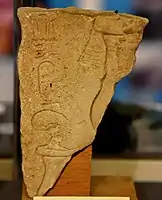 Limestone relief fragment. A princess holding sistrum behind Nefertiti, who is partially seen. Reign of Akhenaten. From Amarna, Egypt. The Petrie Museum of Egyptian Archaeology, London
Limestone relief fragment. A princess holding sistrum behind Nefertiti, who is partially seen. Reign of Akhenaten. From Amarna, Egypt. The Petrie Museum of Egyptian Archaeology, London Siliceous limestone fragment relief of Nefertiti. Extreme style of portrait. Reign of Akhenaten, probably early Amarna Period. From Amarna, Egypt. The Petrie Museum of Egyptian Archaeology, London
Siliceous limestone fragment relief of Nefertiti. Extreme style of portrait. Reign of Akhenaten, probably early Amarna Period. From Amarna, Egypt. The Petrie Museum of Egyptian Archaeology, London Granite head statue of Nefertiti. The securing post at head apex allows for different hairstyles to adorn the head. Altes Museum, Berlin.
Granite head statue of Nefertiti. The securing post at head apex allows for different hairstyles to adorn the head. Altes Museum, Berlin..JPG.webp) Head statue of Nefertiti, Altes Museum, Berlin.
Head statue of Nefertiti, Altes Museum, Berlin.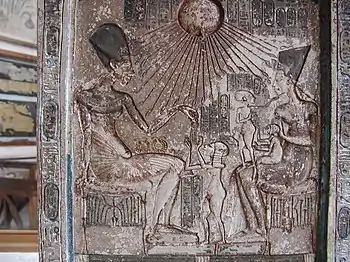 Akhenaten, Nefertiti and their daughters before the Aten. Stela of Akhenaten and his family, Egyptian Museum, Cairo.
Akhenaten, Nefertiti and their daughters before the Aten. Stela of Akhenaten and his family, Egyptian Museum, Cairo. Nefertiti offering oil to the Aten. Brooklyn Museum.
Nefertiti offering oil to the Aten. Brooklyn Museum.
 Relief fragment with Nefertiti, Brooklyn Museum.
Relief fragment with Nefertiti, Brooklyn Museum.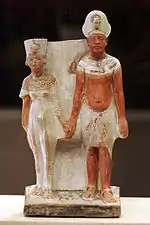 Akhenaten and Nefertiti. Louvre Museum, Paris.
Akhenaten and Nefertiti. Louvre Museum, Paris.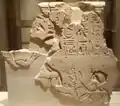

 Boundary stele of Amarna with Nefertiti and her daughter, princess Meketaten, Nelson-Atkins Museum of Art.
Boundary stele of Amarna with Nefertiti and her daughter, princess Meketaten, Nelson-Atkins Museum of Art. Limestone relief of Nefertiti kissing one of her daughters, Brooklyn Museum.
Limestone relief of Nefertiti kissing one of her daughters, Brooklyn Museum. Talatat with an aged Nefertiti, Brooklyn Museum.
Talatat with an aged Nefertiti, Brooklyn Museum.
Cultural depictions
- Nefertiti was portrayed by Geraldine Chaplin in Nefertiti and Akhenaton (1973), Mexican short film of Raul Araiza.
- Nefertiti was also portrayed by Riann Steele in Doctor Who (2012), in the episode Dinosaurs on a Spaceship.
References
- "Akhenaton". Encyclopædia Britannica. Archived from the original on 2007-05-26.
- Jürgen von Beckerath, Chronologie des Pharaonischen Ägypten. Philipp von Zabern, Mainz, (1997), p.190
- "Nefertit or". Collins Dictionary. n.d. Archived from the original on 23 September 2015. Retrieved 24 September 2014.
- RE Freed, S D'Auria, YJ Markowitz (1999). Pharaohs of the Sun: Akhenaten, Nefertiti, Tutankhamen (Museum of Fine Arts, Leiden).
- Dodson, Aidan, Amarna Sunset: Nefertiti, Tutankhamun, Ay, Horemheb, and the Egyptian Counter-Reformation. The American University in Cairo Press. 2009, ISBN 978-977-416-304-3.
- Van de Perre, Athena. 2014. "The Year 16 graffito of Akhenaten in Dayr Abū Ḥinnis: A contribution to the study of the later years of Nefertiti". Journal of Egyptian History 7:67-108.
- Badger Utopia (2017-08-11), Nefertiti - Mummy Queen of Mystery, retrieved 2017-10-30
- Grajetzki, Ancient Egyptian Queens: A Hieroglyphic Dictionary, Golden House Publications, London, 2005, ISBN 978-0-9547218-9-3
- Schenkel, W. "Zur Rekonstruktion deverbalen Nominalbildung des Ägyptischen", Harrasowitz, Wiesbaden. 1983, pp. 212, 214,247
- Allen, James P. (2014-07-24). Middle Egyptian: An Introduction to the Language and Culture of Hieroglyphs. Cambridge University Press. ISBN 978-1-107-05364-9.
- Dodson (2016), p. 87.
- Norman De Garis Davies, The rock tombs of el-Amarna, Parts I and II: Part 1 The tomb of Meryra & Part 2 The tombs of Panehesy and Meyra II, Egypt Exploration Society (2004)
- Norman De Garis Davies, The rock tombs of el-Amarna, Parts V and VI: Part 5 Smaller tombs and boundary stelae & Part 6 Tombs of Parennefer, Tutu and Ay, Egypt Exploration Society (2004)
- Dodson, Aidan and Hilton, Dyan. The Complete Royal Families of Ancient Egypt. Thames & Hudson. 2004. ISBN 0-500-05128-3
- Jacobus Van Dijk, Horemheb and the Struggle for the Throne of Tutankhamun Archived 2016-03-04 at the Wayback Machine, BACE 7 (1996), p.32
- van Dijk, J. (1996). "Horemheb and the Struggle for the Throne of Tutankhamun" (PDF). Bulletin of the Australian Centre for Egyptology: 31–32. Retrieved 15 September 2019.
- Dodson (2016), p. 87–88.
- Tyldesley, Joyce. Nefertiti: Egypt's Sun Queen. Penguin. 1998. ISBN 0-670-86998-8
- Hawas, Zahi; Saleem, Sahar N. (2016). Scanning the Pharaohs: CT Imaging of the New Kingdom Royal Mummies. New York: The American University in Cairo Press. p. 123. ISBN 978-977-416-673-0.
- Redford, Donald B. (1987). Akhenaten, the Heretic King. ISBN 9780691002170.
- Dominic Montserrat, Akhenaten: History, Fantasy and Ancient Egypt, Psychology Press, 2003
- Trope, B., Quirke, S., Lacovara, P., Excavating Egypt. Great Discoveries from the Petrie Museum of Egyptian Archaeology, 2005 ISBN 1-928917-06-2
- Murnane, William J., Texts from the Amarna Period in Egypt, Society of Biblical Literature, 1995 ISBN 1-55540-966-0
- Athena Van der Perreː The Year 16 graffito of Akhenaten in Dayr AbūḤinnis. A Contribution to the Study of the Later Years of Nefertiti, inːJournal of Egyptian History, 7 (2014), 67-108
- "Nefertiti - Ancient History - HISTORY.com". HISTORY.com. Retrieved 2017-10-26.
- AncientHistory (2017-04-28), Nefertiti's Odyssey - National Geographic Documentary, archived from the original on 2019-11-06, retrieved 2017-10-26
- Brand, P. (ed.). "Under a Deep Blue Starry Sky" (PDF). Causing His Name to Live: Studies in Egyptian Epigraphy and History in Memory of William J. Murnane. pp. 17–21. Archived from the original on 2013-10-12.
- AncientHistory (2014-12-16), 'Queen Nefertiti' The Most Beautiful Face of Egypt (Discovery Channel), archived from the original on 2017-03-08, retrieved 2017-10-26
- Badger Utopia (2017-08-11), Nefertiti - Mummy Queen of Mystery, retrieved 2017-10-26
- Reeves, Nicholas. Akhenaten: Egypt's False Prophet. p.172 Thames & Hudson. 2005. ISBN 0-500-28552-7
- Van der Perre, Athena (2012). Seyfried, Friederike (ed.). In the Light of Amarna : 100 Years of the Nefertiti discovery. Ägyptisches Museum und Papyrussammlung, Staatliche Museen zu Berlin. pp. 196–197. ISBN 978-3-86568-848-4.
- Van der Perre, Athena (18 August 2014). "The Year 16 graffito of Akhenaten in Dayr Abū Ḥinnis. A Contribution to the Study of the Later Years of Nefertiti". Journal of Egyptian History. 7 (1): 68. doi:10.1163/18741665-12340014.
- Van der Perre, Athena (2012). Seyfried, Friederike (ed.). In the Light of Amarna : 100 Years of the Nefertiti discovery. Ägyptisches Museum und Papyrussammlung, Staatliche Museen zu Berlin. p. 197. ISBN 978-3-86568-848-4.
- Van der Perre, Athena (18 August 2014). "The Year 16 graffito of Akhenaten in Dayr Abū Ḥinnis. A Contribution to the Study of the Later Years of Nefertiti". Journal of Egyptian History. 7 (1): 73. doi:10.1163/18741665-12340014.
- Van der Perre, Athena (18 August 2014). "The Year 16 graffito of Akhenaten in Dayr Abū Ḥinnis. A Contribution to the Study of the Later Years of Nefertiti". Journal of Egyptian History. 7 (1): 76. doi:10.1163/18741665-12340014.
- Van der Perre, Athena (18 August 2014). "The Year 16 graffito of Akhenaten in Dayr Abū Ḥinnis. A Contribution to the Study of the Later Years of Nefertiti". Journal of Egyptian History. 7 (1): 77. doi:10.1163/18741665-12340014.
- Murnane, William J. (1995). Texts from the Amarna period in Egypt. United States of America: Scholars Press. p. 78. ISBN 1-55540-966-0.
- Dodson, Aidan (2018). Amarna sunset : Nefertiti, Tutankhamun, Ay, Horemheb, and the Egyptian counter-reformation (Revised ed.). Cairo: The American University in Cairo Press. p. 18. ISBN 978-977-416-859-8.
- Kemp, Barry (2014). The city of Akhenaten and Nefertiti : Amarna and its people (Paperback ed.). New York: Thames & Hudson. p. 255. ISBN 978-0-500-29120-7.
- Kemp, Barry. The Amarna Royal Tombs at Amarna (PDF). p. 6. Archived (PDF) from the original on 2022-10-09. Retrieved 1 July 2019.
- Martin, Sean (August 11, 2015). "Archaeologist believes hidden passageway in tomb of Tutankhamun leads to resting place of Nefertiti". International Business Times.
- "Radar Scans in King Tut's Tomb Suggest Hidden Chambers". National Geographic News. 28 November 2015. Retrieved 30 June 2019.
- Sambuelli, Luigi; Comina, Cesare; Catanzariti, Gianluca; Barsuglia, Filippo; Morelli, Gianfranco; Porcelli, Francesco (May 2019). "The third KV62 radar scan: Searching for hidden chambers adjacent to Tutankhamun's tomb". Journal of Cultural Heritage. 39: 8. doi:10.1016/j.culher.2019.04.001. S2CID 164859865.
- Sambuelli, Luigi; Comina, Cesare; Catanzariti, Gianluca; Barsuglia, Filippo; Morelli, Gianfranco; Porcelli, Francesco (May 2019). "The third KV62 radar scan: Searching for hidden chambers adjacent to Tutankhamun's tomb". Journal of Cultural Heritage. 39: 9. doi:10.1016/j.culher.2019.04.001. S2CID 164859865.
- James, Susan E. (Summer 2001). "Who is Mummy Elder Lady?". KMT. Vol. 12, no. 2.
- Harris, James E.; Wente, Edward F.; Cox, Charles F.; El Nawaway, Ibrahim; Kowalski, Charles J.; Storey, Arthur T.; Russell, William R.; Ponitz, Paul V.; Walker, Geoffrey F. (1978). "Mummy of the "Elder Lady" in the Tomb of Amenhotep II: Egyptian Museum Catalog Number 61070". Science. 200 (4346): 1149–51. Bibcode:1978Sci...200.1149H. doi:10.1126/science.349693. JSTOR 1746491. PMID 349693.
- Hawass, Z.; Gad, Y. Z.; Ismail, S.; Khairat, R.; Fathalla, D.; Hasan, N.; Ahmed, A.; Elleithy, H.; Ball, M.; Gaballah, F.; Wasef, S.; Fateen, M.; Amer, H.; Gostner, P.; Selim, A.; Zink, A.; Pusch, C. M. (2010). "Ancestry and pathology in King Tutankhamun's family". JAMA. 303 (7): 638–47. doi:10.1001/jama.2010.121. PMID 20159872.
- "Weekly Column - Dr. Zahi Hawass". 27 September 2007. Archived from the original on September 27, 2007. Retrieved 8 June 2016.
{{cite web}}: CS1 maint: unfit URL (link) - Hawass, Zahi; Gad, Yehia Z.; Somaia, Ismail; Khairat, Rabab; Fathalla, Dina; Hasan, Naglaa; Ahmed, Amal; Elleithy, Hisham; Ball, Markus; Gaballah, Fawzi; Wasef, Sally; Fateen, Mohamed; Amer, Hany; Gostner, Paul; Selim, Ashraf; Zink, Albert; Pusch, Carsten M. (February 17, 2010). "Ancestry and Pathology in King Tutankhamun's Family". Journal of the American Medical Association. Chicago, Illinois: American Medical Association. 303 (7): 638–647. doi:10.1001/jama.2010.121. ISSN 1538-3598. PMID 20159872. Retrieved May 24, 2020.
- Hawass, Zahi; Saleem, Sahar N. (2016). Scanning the Pharaohs: CT Imaging of the New Kingdom Royal Mummies. New York: American University in Cairo Press. pp. 132–142. ISBN 978-977-416-673-0.
- Güterbock, Hans Gustav (June 1956). "The Deeds of Suppiluliuma as Told by His Son, Mursili II (Continued)". Journal of Cuneiform Studies. 10 (3): 75–98. doi:10.2307/1359312. JSTOR 1359312. S2CID 163670780.
- Schulman, Alan R. (1979). "Diplomatic Marriage in the Egyptian New Kingdom". Journal of Near Eastern Studies. 38 (3): 179–180. doi:10.1086/372739. JSTOR 544713. S2CID 161228521.
- Güterbock, Hans Gustav (September 1956). "The Deeds of Suppiluliuma as Told by His Son, Mursili II". Journal of Cuneiform Studies. 10 (4): 107–130. doi:10.2307/1359585. JSTOR 1359585. S2CID 224824543.
- Amelie Kuhrt (1997). The Ancient Middle East c. 3000 – 330 BC. Vol. 1. London: Routledge. p. 254.
- Lloyd, Alan B. (6 May 2010). A Companion to Ancient Egypt. John Wiley & Sons. p. 14. ISBN 978-1-4443-2006-0. Retrieved 19 April 2022.
- Darnell, John Coleman; Manassa, Colleen (3 August 2007). Tutankhamun's Armies: Battle and Conquest During Ancient Egypt's Late Eighteenth Dynasty. John Wiley & Sons. p. 186. ISBN 978-0-471-74358-3. Retrieved 19 April 2022.
- Matthews, Roger; Roemer, Cornelia, eds. (16 September 2016). Ancient Perspectives on Egypt. Routledge. p. 98. ISBN 978-1-315-43491-9. Retrieved 19 April 2022.
- Grajetzki, Wolfram (2000). Ancient Egyptian Queens; a hieroglyphic dictionary. London: Golden House. p. 64.
- Nicholas Reeves,Tutankhamun's Mask Reconsidered BES 19 (2014), pp.523
- Johnson, W. Raymond (1996). "Amenhotep III and Amarna: Some New Considerations". The Journal of Egyptian Archaeology. 82: 76. doi:10.1177/030751339608200112. JSTOR 3822115. S2CID 193461821.
Works cited
- Dodson, Aidan (2016) [1st pub. 2014]. Amarna Sunrise. Egypt from Golden Age to Age of Heresy. Cairo; New York City: American University in Cairo Press. ISBN 9781617975608.
.jpg.webp)